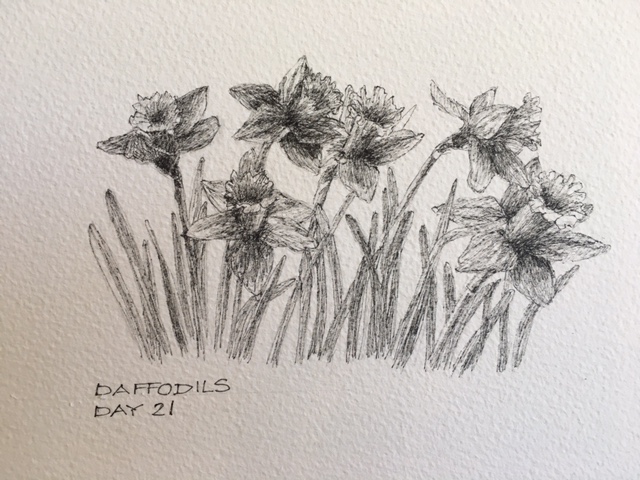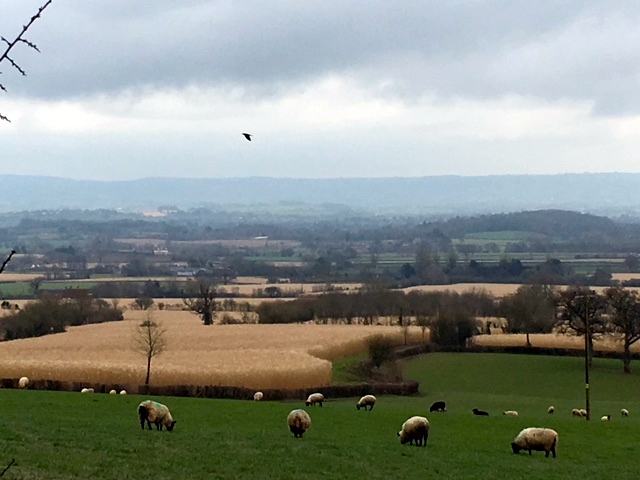From: Combe Florey to North Petherton
Distance: 12m / 19.2km
Cumulated distance: 259.2m / 417km
Percentage completed: 25.2

I lost count of the times today when I nearly fell into the mud, over stiles or into puddles from laughing. My companion was on fine form telling stories and jokes .. seeing the humorous side in most everything. Even when I found it just about impossible to find the elusive Macmillan Way West and took her off-piste several times, she remained in fine fettle .. without a word of blame. (‘Yeah, you seem to be able to find me The Green Way, The Coleridge Way, The West Deane Way but no flippin’ MacMillan Way’, she now chirps.)
There was a definite theme of treasure today. It started with us thanking the two treasures, Nell and Graham at The Old Stag’s Head for their kind hospitality and generous donation to SANE. http://www.tauntonbandb.co.uk/contact-us
The idea was to reconnect with the Macmillan Way West by first walking to West Bagborough. It was another soft day .. mist and a little gentle drizzle. The Quantocks were shrouded in cloud, making them barely visible.

Mist over the hills
In 2001 a British copper called James Hawkesworth, was out walking in a field close to West Bagborough, when the metal detector he was carrying went berserk. Gentle, or more likely, frantic digging at the spot revealed what became known as The West Bagborough Hoard .. 670 Roman coins and 72 pieces of hacksilver. Sadly for PC Hawkesworth the find was declared a ‘treasure’. Sadly, because the heap of coins worth £40,000 today’s, became the property of the state, rather than swelling his own bank account. The concept of ‘treasure trove’ in English law dates back to 1066. The law says that any collection of silver or gold which has been hidden and is rediscovered later when the hiders of the treasure are long since dead, becomes the property of the Crown.
As we crossed the first of the muddy fields, we could hear gales of giggles coming from the other side of the hedge. Turned out to be a couple of fit-looking cyclists, making their way up the hill. We all stopped for a chat, like you do and before long I found out that one of them had cycled from Land’s End to John o’Groats, just a couple of years ago. She’d been the youngest in the group who made the journey, accompanied by a dozen octogenarians. She regaled some of her memories of the trip with infectious joy .. I so hope that she goes ahead and publishes her story .. I’ll be the first in line to buy it.

Lovely LEJOGer cyclist
As we stumbled over the first of many stiles, we realised we weren’t only amusing ourselves but also a bunch of extremely curious lamas in the next field. There they stood, posing like Elite models with freshly coiffed hair.

Coiffed lamas
We asked if they’d mind us taking a selfie with them ..

Does our hair meet the grade?
They were terribly obliging. But then of course, there’s always a photo bomber ..

Pick me! Pick me!
We eventually tore ourselves away from the woolly wonders and headed off in pursuit of the Macmillan Way West. En route we had to cross Wheddon’s Farm, extremely slowly ..

Onwards and upwards. To Cothelstone. And it’s manor house and beautiful parklands and church.

Cothelstone
Bearing in mind Conrad’s advice, we called in at the church. St Thomas of Canterbury Church at Cothelstone dates from the 12th century and when we visited, two members of the parish were there, busy polishing the brass. The stone and alabaster effigies were beautiful.

Sir Matthew and Lady Eleanor Stawell. 14th century

Sir John Stawell and his wife Frances Dyer. 1603.
Once again, we were the recipients of coffee kindness, courtesy of the church. Thank you so much, lovely ladies.

Home-made jams from the Manor’s organic farm for sale in the church
As the Macmillan Way West eluded us we wandered, lonely as clouds, above golden fields of Miscanthus giganteus, known commonly as elephant grass. It looked amazingly sculptural.

Miscanthus

Fields of Elephant Grass
Even though we were tramping through Somme-like proportions of mud, Adi still found time to make friends with a pheasant. Every other pheasant we’d met so far had been as timid as a church mouse but this one was positively flirtatious. He would have followed her to the ends of the earth.

Freakishly familiar pheasant
The Macmillan Way West remained mystical, mysterious and quite frankly just unfindable. No sooner did we find it than it disappeared .. although this probably says more about my map-reading than the Way. (Soft sardonic grunt from Adi!). In its pursuit we encountered more mud than I thought could possibly exist, even on the Mudbank. It certainly impressed the receptionist at the hotel at the end of the day when I walked in carrying most of it on my boots .. not necessarily in a good way.

Mud and water in extremis .. quite impressive to a drought-familiar Cape Townian

Glorious? Not so much
Our destination for the day was North Petherton. Apart from Chaucer possibly having lived there, the town’s biggest claim to fame is the discovery of the beautiful Alfred Jewel, found also in a field in 1693, almost 800 years after it had been lost. It had belonged to Alfred the Great, king of the West Saxons. Alfred was one of only two monarchs to earn the epithet Great in UK (Cnut’s the other one) and he’s still considered to have been one of the most enlightened. But being enlightened doesn’t necessarily make you a great cook and ironically, if there’s one thing English school children will know about Alfred the Great, it is that he burnt the cakes, whilst hiding in a peasant woman’s kitchen … and that she scolded him roundly for it. Yeah, he successfully defended his country against the Vikings and ok, he improved the kingdom’s legal system, military structure and significantly raised the standard of living for all .. but he still burnt the cakes. Mary Berry would never have called him Great .. but maybe Jamie Oliver would have been more understanding!
Black Dog Tails
Meet Lucky and Flo. They were the first dogs to detect optical discs by sniffing them out. They’ve uncovered thousands of counterfeit dvds at airports. Clever dogs!
![]()




Jules …. enjoying your news so much! Brilliant writing and fabulous to read! Well done to you! Await tomorrow!!
Hugs
Jane x
So kind of you, Jane .. it’s proving to be a lot of fun! xx
Well you muddy Llama wannabees, Wikipedia says of my Way: “The fully waymarked route follows existing footpaths, bridleways and byways, and small stretches of minor roads when these are unavoidable.” So get your compass out and peel your eyes, ladies… maybe less Black Dog gin???
In your dreams, Doug! Intermittent peeling stickers at best. But now I’ve lost my companion maybe the gin will play a less prominent role!
Love your Lamas. There was once some joking on my blog about using lamas to carry ones kit etc. I faked up a photo with Photoshop of me on a lama and many people were completely taken in – here is the link to the photo in Dropbox: https://www.dropbox.com/s/mkcnj6fo5ic22oa/LlamaCHR%20copy.jpg?dl=0
I went through Bridgewater, ended up at b and b King’s Farm, Bawdrip, north east of Bridgewater. James 2nd used the farm as his headquarters for the battle of Sedgmoor in 1685.
I camped 48 out of my 77 nights.
I’m intrigued to see where your route goes next – looks a bit problematical on the map.
Loved the photo! I can see why so many people were taken in. The 15 miles today felt all wrong, heading south east but it was nice to follow the river. From tomorrow I’ll be heading north and joining the Macmillan Way. Sure it will help my map reading to be holding it the right way round! Well done you for all that camping .. I know I couldn’t hack that.
Quarter of the way there- well done! Love reading about your daily progress and adventures – still jealous, despite the muddy stories….
Hardly feels possible to have done a quarter already! Great having your support. xx
Jules , you are amazing and very inventive to try and clock in way more km than you should , with all your fun detours in search of the Mc Millan way you will reach 2000km in no time my friend . Just loved your lamas , they are irresistible ! So are you and Adi .
Very inspired to paint with your “Mist over the hills ” photo !
Much love xox
Oh, I would so love to see a Dalgleish painting of the ‘Mist over the hills’ .. please use the photo if you feel inspired to do so. Thinking of you often as I plan paintings in my head for our show together next year. Thought you’d appreciate the lamas .. I didn’t have to try to hard to emulate their hair style!! Much love xx
Oh, I remember copious amounts of mud and so much rain. All part of English countryside of course. Interesting to see the different route you are following to the way we walked. I am enjoying your blog so much and this one made me smile. xx
There may have been oodles of mud but I’ve been lucky so far with the absence of rain. Glad I raised a smile .. it really was the funniest of days and evenings. xx
Dear Jules – more of your fascinating tales! I love the elephant grass – haven’t seen it before. As I read everything this morning an idea crept in….trace your family tree – if you haven’t already done it – and walk where it takes you. And please can I come too and do mine!!❤️
Frannie, that has the makings of a very good book too! I think of you often along the journey. xx
Back on wifi after a week without and I am binging on your blogs…..better than an Archers omnibus! You are clearly becoming a mud expert. Wishing you some drier ground and more clearly marked paths xx
Too kind, Alex! Hope you had a wonderful time in the sun and that you’re planning to bring some back with you to dry up all the mud.. xx